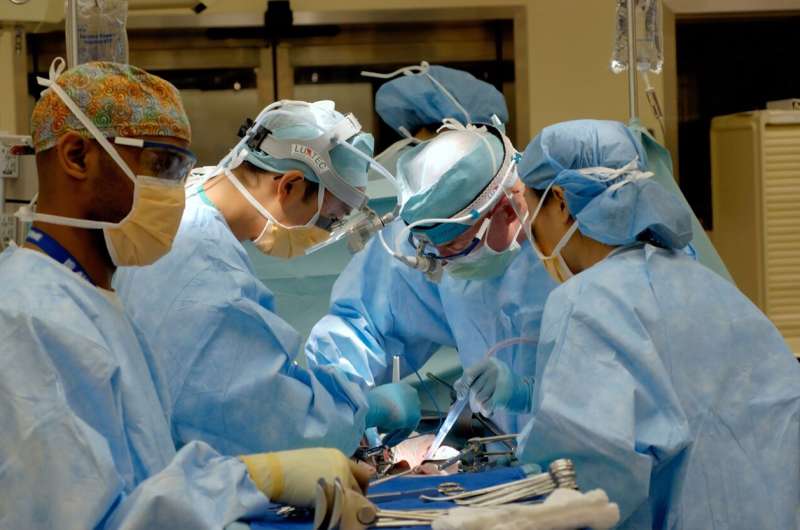This article has been reviewed according to Science X's editorial process and policies. Editors have highlighted the following attributes while ensuring the content's credibility:
fact-checked
trusted source
proofread
Optical coherence tomography shown to improve stent implantation outcomes in bifurcation lesions

Percutaneous coronary intervention (PCI) guided by optical coherence tomography (OCT) reduces adverse cardiac events in patients with bifurcation lesions, according to late breaking research presented in a Hot Line session August 27 at ESC Congress 2023.
In approximately 15%–20% of coronary revascularizations performed by PCI, the lesion is located in a branch point (bifurcation) of the coronary arteries. PCI involving a bifurcation lesion is often technically challenging, angiographic ambiguity is high and the prognosis is worse than for treatment of simpler lesions. OCT is a newer high-resolution intravascular imaging modality that allows for detailed characterization of atherosclerosis and of the treatment steps during PCI.
OCTOBER was the first adequately powered clinical trial to examine whether routine use of OCT during PCI of complex bifurcation lesions improves clinical outcomes compared to standard practice with angiographic guidance and optional use of intravascular ultrasound (IVUS) in left main bifurcations.
Patients with complex bifurcation lesions requiring PCI were randomly allocated in a 1:1 ratio to OCT-guided PCI or angiography-guided PCI. OCT-guided PCI was performed according to a detailed treatment protocol which included stepwise evaluation of (1) lesion preparation, (2) lesion length, (3) reference sizes, (4) lesion coverage, (5) stent expansion, (6) malapposition, (7) wire positions, and (8) ostial results. Investigators received training and core lab feedback on OCT-guided procedures throughout the trial. In the angiography-guided arm, the use of IVUS was allowed in cases requiring treatment of left main artery stenosis.
The primary endpoint was major adverse cardiac events (MACE), defined as a composite of cardiac death, target lesion myocardial infarction, and ischemia-driven target lesion revascularization, after two years. Secondary endpoints included all-cause mortality, cardiac death, target lesion myocardial infarction, and target lesion revascularization. All endpoints were adjudicated by an independent clinical endpoint committee blinded to treatment allocation.
The trial included 1,201 patients from 38 heart centers across 13 European countries. A total of 600 patients were allocated to OCT-guided PCI and 601 patients were allocated to angiography-guided PCI. The average age of participants was 66 years, and 21% of patients in both groups were women.
The primary endpoint of MACE after two years occurred in 10.1% of patients in the OCT-guided PCI group and 14.1% of patients in the angiography-guided PCI group, for a Kaplan-Meier estimated hazard ratio (HR) of 0.70 (95% confidence interval [CI] 0.50-0.98, p=0.035).
Differences in secondary clinical endpoints after two years did not reach statistical significance, but the trial was not powered for these endpoints. All-cause death occurred in 2.4% and 4.0% of patients in the OCT-guided PCI and angiography-guided PCI arms, respectively, for a HR of 0.56 (95% CI 0.28-1.10). Cardiac death occurred in 1.4% and 2.6% of patients in the OCT-guided PCI and angiography-guided PCI groups, respectively, for a HR of 0.53 (95% CI 0.22-1.25). Target lesion myocardial infarction occurred in 7.8% and 8.5% patients in the OCT-guided and angiography-guided arms, respectively, for a HR of 0.90 (95% CI 0.60-1.34), while target lesion revascularization occurred in 3.1% and 5.0% patients, respectively, for an HR of 0.63 (95% CI 0.35-1.15).
There were no apparent differences in procedural safety, but the volume of contrast and the procedure time were both increased with OCT-guided PCI compared with angiography-guided PCI.
Study author Dr. Lene Nyhus Andreasen of Aarhus University Hospital, Denmark said, "The OCTOBER trial demonstrated that in patients with complex bifurcation lesions, OCT-guided PCI was associated with better outcomes after two years than angiography-guided PCI. Procedures using OCT guidance were safe but took longer and the investigators used more contrast.
"In the angiography-guided arm, IVUS was also used in approximately one in five cases, which reflects current clinical practice for complex PCI procedures in many centers. The results suggest that routine use of structured OCT guidance during PCI of complex bifurcation lesions should be considered to improve prognosis."



















